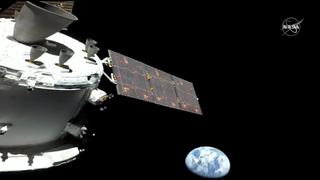
NASA's Artemis 1 Orion capsule is exceeding expectations in deep space and remains on target to fly by the moon on Monday (Nov. 21), agency officials said.
The Artemis 1 mission launched on Wednesday morning (Nov. 16), sending an uncrewed Orion toward the moon atop a huge Space Launch System (SLS) rocket. This is Orion's first-ever journey beyond Earth orbit, but the capsule has been checking boxes like a veteran, mission team members said.
"Orion has been performing great so far," Jim Geffre, NASA's Orion vehicle integration manager, said during a press briefing on Friday afternoon (Nov. 18). "All of the systems are exceeding expectations from a performance standpoint."
Related: Amazing views of NASA's Artemis 1 moon rocket debut (photos)
Live updates: NASA's Artemis 1 moon mission
Orion will reach the moon on Monday (Nov. 21), skimming just 81 miles (130 kilometers) above the dusty gray surface at 7:44 a.m. EST (1244 GMT). The mission plan calls for the capsule to conduct a crucial 2.5-minute-long engine burn during that close approach, a maneuver that will set the stage for insertion into lunar orbit four days later.
Artemis 1 team members will decide whether or not to commit to that "powered flyby burn" following a meeting on Saturday (Nov. 19). It would be surprising at this point, however, if they ended up changing the plan.
"Right now we're looking good, and we're ready to go continue executing," Artemis 1 Flight Director Jeff Radigan said during Friday's briefing.
Get the Space.com Newsletter
Breaking space news, the latest updates on rocket launches, skywatching events and more!
That's not to say the flight has gone perfectly smoothly. Thirteen anomalies, or "funnies," have been detected during Orion's cruise so far, mission team members said on Friday.
One such problem was a set of erratic readings from Orion's star trackers, which the capsule uses to navigate. This initially puzzled the team, but they eventually determined that the trackers were being dazzled by the glow from Orion's thrusters during burns. With the cause identified, the team has been able to work through the issue, as they have the other 12 funnies, which were all minor glitches.

The issues may be more serious for some of the 10 cubesats that launched on Artemis 1 as rideshare payloads. While all of them deployed from the SLS upper stage as planned, only five are now behaving as expected, Artemis 1 mission manager Mike Sarafin said during the briefing.
ArgoMoon, BioSentinel, Equuleus, LunaH-Map and OMOTENASHI "are on a path to success," Sarafin said.
The other five — which are LunIR, Lunar IceCube, NEA Scout, CuSP and Team Miles — "either have encountered technical issues post-deploy or have had intermittent communications or, in one case, did not acquire a signal with the communication asset that they had planned," he added.
Sarafin stressed, however, that he and other Artemis 1 team members don't have the best or most up-to-date information about the cubesats, which are independent spacecraft operated by a variety of different groups. OMOTENASHI, for example, is a tiny Japanese probe that aims to drop a 2.2-pound (1 kilogram) lander on the lunar surface.
Sarafin also disclosed that Artemis 1's mobile launch tower was damaged somewhat by the SLS, the most powerful rocket ever to launch successfully.
For example, pressure waves generated by the SLS's 8.8 million pounds of thrust blew the blast doors off the tower's elevators during Wednesday's liftoff, which was the first ever for the giant rocket. (Orion had one flight under its belt before Artemis 1, a 2014 test flight to Earth orbit atop a United Launch Alliance Delta IV Heavy rocket.)
That's not exactly a surprise; the team had expected the SLS to give the tower a bit of a beating, Sarafin said. Technicians have not yet been able to fully assess the launch tower's condition, but they're working on it.
"The team is proceeding out of an abundance of caution to get the full system status for the mobile launcher, and they're working their way through that," Sarafin said.
If everything goes according to plan with Monday's flyby burn, Orion will then gear up for another crucial engine firing on Nov. 25. That one will insert the capsule into a lunar distant retrograde orbit, which will take Orion as far as 40,000 miles (64,000 km) from the moon's surface.
The capsule will stay in that orbit until Dec. 1, when it will conduct another burn to set it on course for Earth. Orion will splash down softly under parachutes on Dec. 11 in the Pacific Ocean off the California coast, if all goes according to plan.
Mike Wall is the author of "Out There" (Grand Central Publishing, 2018; illustrated by Karl Tate), a book about the search for alien life. Follow him on Twitter @michaeldwall. Follow us on Twitter @Spacedotcom or Facebook.
Join our Space Forums to keep talking space on the latest missions, night sky and more! And if you have a news tip, correction or comment, let us know at: community@space.com.

Michael Wall is a Senior Space Writer with Space.com and joined the team in 2010. He primarily covers exoplanets, spaceflight and military space, but has been known to dabble in the space art beat. His book about the search for alien life, "Out There," was published on Nov. 13, 2018. Before becoming a science writer, Michael worked as a herpetologist and wildlife biologist. He has a Ph.D. in evolutionary biology from the University of Sydney, Australia, a bachelor's degree from the University of Arizona, and a graduate certificate in science writing from the University of California, Santa Cruz. To find out what his latest project is, you can follow Michael on Twitter.
